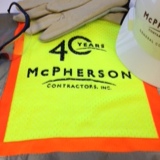Information
-
Job Site
-
PM/Super
-
Conducted on
-
Prepared by
-
Location
1. 1926.501 Duty to have fall protection.
-
1. 1926.501(b)(1) Are all workers above 6 feet protected from falls?
-
1.2 1926.502(d)(12) Are restraining devices used correctly in JLGs?
-
1.3. 1926.502 Unsafe or incomplete edge protection, toe boards?
2. 1926.600 Equipment
-
2.1 1926.601(b)(14) Is equipment inspected before use?
-
2.2 1910.178 Are operators trained, and holding certs as required?
-
2.3. 1926.602(c)(1)(ii) Unsafe or incompatible attachments used with equipment?
-
2.4. 1910.178(l) Unlicensed operators?
-
2.5. 1926.601 Are employee working around equipment given safe work instructions?
-
2.6. 1926.602 Is equipment, trucks backing up with spotters?
-
2.7. 1926.600(a)(3)(i) Lack of LOTO procedures for cleaning, servicing and maintenance?
-
2.8. 19266.602(a)(2) Are seat belts used and meet the requirements of Automotive Engineers J386-1969?
3. 1926.450 Scaffold
-
3.1. 1926.451 (a)(6) Are competent persons directing scaffold insulation?
-
3.2. 1926.451 Unsafe or incomplete scaffold?
-
3.3. 1926.451(f)(3) Lack of inspection protocol for scaffold?
-
3.4. 1926.452 Incompatible scaffold components? Unlabelled or do not meet AS?
-
3.5. 1926.452 Safe Work Load (SWL) exceeded? (tools, stored materials, number of persons)
4. 1926.550 Cranes and Lifting Equipment
-
4.1. 1926.550(a) Unsafe or damaged plant?
-
4.2. 1926.550(a)(15)(iv) Loads lifted over persons, close proximity to obstacles incl. overhead power lines?
-
4.3. 1926.550(a)(5) Lack of maintenance, testing and inspection?
-
4.4. 1926.550(a)(2) Lack of SWL information displayed?
-
4.5. 1926.550(a)(5) Lack of daily inspection protocol?
-
4.6. 1926.550(a)(7)(vi) Unsafe or damaged lifting equipment, including ropes, slings, chains, hooks?
-
4.7.1926.550(a)(2) Lifting equipment unlabelled, does not meet AS, no SWL displayed?
-
4.8. Unlicensed operators?
-
4.9. 1926.550 Lack of LOTO procedures for cleaning, servicing and maintenance?
-
4.10. 1926.550(f)(1)(ii) SWL of plant or any lifting equipment exceeded?
5. 1926.500 Fall Protection, Harness and Equipment
-
5.1. 1926.502(a)(2) Unsafe or damaged harness or equipment?
-
5.2. 1926.502 Incompatible hooks/equipment?
-
5.3. 1926.500(a) Unlabelled or does not meet AS?
-
5.4. 1926.502(d)(15) Unsafe or uncertified anchor points?
-
5.5. 1926.502(d) Lack of inspection protocol for equipment?
-
5.6. 1926.502(d) Lack of or inadequate formal training for operators?
6. 1926.1050 Ladders and Stairs
-
6.1. 19261053 Unsafe or damaged ladders?
-
6.2. 1926.1053 Unsafe positioning of ladders?
-
6.3. 1926.5053 Ladder not properly secured?
-
6.4. 1926.1052 Stairway or Ladder unsuitable or not inspected.
7. Subpart Z toxic and hazardous materials
-
7.1. 1926.55 (b) Lack of identification hazardous manual tasks?
-
7.2. 1926.55 (a) Lack of assessment of hazardous manual tasks?
-
7.3. Subpart Z Inadequate risk controls? (examples: no job rotation, lighter loads, trolleys, lifting equipment, etc)
-
7.4. 1926.59 Lack of training in risk controls and safe lifting/ team lifting techniques?
8. Hazardous Chemical (including fuel and oil)
-
8.1. Unsafe storage location? (e.g. flammables near ignition sources, spills could enter stormwater drains, etc)
-
8.2. Incompatible chemicals stored near each other?
-
8.3. Inadequate spill containment equipment?
-
8.4. Safety Data Sheets not accessible on site?
-
8.5. Lack of emergency procedures for injury/spills/fire etc?
-
8.6. Excessive quantities stored on site or in vehicles?
-
8.7. Insufficient ventilation?
-
8.8. Insufficient, or incorrect, PPE?
-
8.9. Unsuitable storage containers? (unlabeled or stored in food containers)
9. Emergency Response
-
9.1. Lack of, or no emergency plans for site?
-
9.2. Emergency procedures not displayed at site?
-
9.3. Lack of training and rehearsal of emergency plans?
-
9.4. Lack of, or inadequate first aid kits aid equipment for site?
-
9.5. Insufficient access to formally trained First Aiders for all shifts?
-
9.6. Unsuitable or inadequate communication equipment?
10. Traffic Management
-
10.1. Lack of, or inadequate, Traffic Management Plan (TMP) in place?
-
10.2. Lack of training in TMP for all persons on site? <br>(contractors and visitors)
-
10.3. Inadequate controls for TMP? (physical barriers, bollards, speed limits, flashing lights, spotters, etc)
11. 1926.28 Personal Protective Equipment (PPE)
-
11.1. 1926.95 Lack of, or inadequate PPE (including sun protection)
-
11.2. 1926.95 Are PPE's in use including hard hat safety glasses reflective vest face shields and steel toed boots?
-
11.3. 1926.52 Is Hearing protection being used as needed
12. Subpart C Work Environment
-
12.1. 1926.27 Lack of/or inadequate amenities? (toilets, wash areas, lunch rooms, etc)
-
12.2. 1926.26 Insufficient lighting?
-
12.3. 1926.25 Inadequate housekeeping?
-
12.4. 1926.28 Lack of, or inadequate noise/ vibration control?
13. 1926.400 Electrical Hazards
-
13.1. 1926.405 (g)(i) Unsafe electrical leads? (damaged, out of test date or untested)
-
13.2. 1926.404(b)(1)(ii) Are ground fault circuit interrupters in use and tested weekly?
-
13.3. 1926.400 (b) As underground marketing services been contacted and marked the ground for utilities?
-
13.4. 1926.403 (i)(1)(i) Contact with overhead electrical lines?
-
13.5. 1926.404 (b)(1)(ii) Overloading outlets?
-
13.6. 1926.405 (g) Drop chords placed on ground or on metal structures?
-
13.7. 1926 405 (e) Electrical equipment near water?
-
13.8. 1926.403 (i)(1)(ii) Is electrical equipment and wires clear of hazards?
-
13.9. 1926.403(I)(2) On all live electrical components guarded from accidental contact and cabinets locked?
-
13.10. Electrical leads that may be damaged from contact with moving machinery parts?
-
13.11. 1926.404 Electrical leads on working walking Protected and not creating trip hazards?
-
13.12. NFPE 70 Is the NFPE 70 being followed for Lock-out/tag-out (LOTO) procedures for electrical equipment?<br><br><br>
14. Environmental Hazards
-
14.1. Lack of/or inadequate Environmental Management plan (EMP)?
-
14.2. Lack of/or inadequate, dust suppression system?
-
14.3. Lack of/or inadequate systems to prevent contaminants entering stormwater drains?
-
14.4. Lack of water re-use systems?
15. Administrative Procedures
-
15.1. Lack of/or inadequate Site Safety Plan?
-
15.2. Failure to obtain permits (Council, EPA, WHS, also Hot Works, Confined Space etc)
-
15.3. Lack of, or inadequate, induction for workers, contractors, visitors?
-
15.4. Lack or, or inadequate, supervisory arrangements?
-
15.5. Lack of/or inadequate training, licenses, skills, experience?
-
15.6. Lack of/or inadequate Safe Work Method Statements (SWSM) for high- risk work?
-
15.7. Lack of, or inadequate system to review SWMS as needed?
-
15.8. Lack of/or inadequate incident notification procedures?
-
15.9. Lack of, or inadequate, routine inspections, monitoring, audits?
-
15.10. Lack of/or inadequate consultative arrangements?
Corrective Actions
-
Enter any corrective actions that will be undertaken
Sign Off
-
On site representative
-
Auditor's signature









